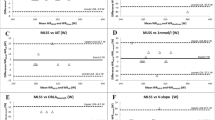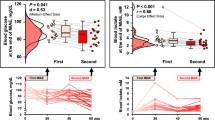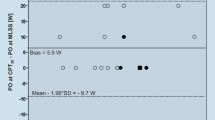Abstract
The aim of the study was to investigate the independent relationship between maximal lactate steady state (MLSS), blood lactate concentration [La] and exercise performance as reported frequently. Sixty-two subjects with a wide range of endurance performance (MLSS power output 199 ± 55 W; range: 100–302 W) were tested on an electronically braked cycle ergometer. One-min incremental exercise tests were conducted to determine maximal variables as well as the respiratory compensation point (RCP) and the second lactate turn point (LTP2). Several continuous exercise tests were performed to determine the MLSS. Subjects were divided into three clusters of exercise performance. Dietary control was employed throughout all testing. No significant correlation was found between MLSS [La] and power output at MLSS. Additionally, the three clusters of subjects with different endurance performance levels based on power output at MLSS showed no significant difference for MLSS [La]. MLSS [La] was not significantly different between men and women (average of 4.80 ± 1.50 vs. 5.22 ± 1.52 mmol l−1). MLSS [La] was significantly related to [La] at RCP, LTP2 and at maximal power. The results of this study support previous findings that MLSS [La] is independent of endurance performance. Additionally, MLSS [La] was not influenced by sex. Correlations found between MLSS [La] and [La] at maximal power and at designated anaerobic thresholds indicate only an association of [La] response during incremental and MLSS exercise when utilizing cycle ergometry.


Similar content being viewed by others
References
Almarwaey OA, Jones AM, Tolfrey K (2004) Maximal lactate steady state in trained adolescent runners. J Sports Sci 22(2):215–225
Aunola S, Rusko H (1992) Does anaerobic threshold correlate with maximal lactate steady state? J Sports Sci 10(4):309–329
Bacon L, Kern M (1999) Evaluating a test protocol for predicting maximum lactate steady state. J Sports Med Phys Fitness 39(4):300–308
Baron B, Dekerle J, Robin S, Neviere R, Dupont L, Matran R, Vanvelcenaher J, Robin H, Pelayo P (2003) Maximal lactate steady state does not correspond to a complete physiological steady state. Int J Sports Med 24(8):582–587
Beneke R (1995) Anaerobic threshold, individual anaerobic threshold, and maximal lactate steady state in rowing. Med Sci Sports Exerc 27(6):863–867
Beneke R, Heck H, Schwarz V, Leithauser R (1996) Maximal lactate steady state during the second decade of age. Med Sci Sports Exerc 28(12):1474–1478
Beneke R, von Duvillard SP (1996) Determination of maximal lactate steady state response in selected sports events. Med Sci Sports Exerc 28(2):241–246
Beneke R, Hutler M, Leithauser RM (2000) Maximal lactate-steady-state independent of performance. Med Sci Sports Exerc 32(6):1135–1139
Beneke R, Leithauser RM, Hutler M (2001) Dependence of the maximal lactate steady state on the motor pattern of exercise. Br J Sports Med 35(3):192–196
Beneke R (2003a) Experiment and computer-aided simulation: complementary tools to understand exercise metabolism. Biochem Soc Trans 31:1263–1266
Beneke R (2003b) Methodological aspects of maximal lactate steady state-implications for performance testing. Eur J Appl Physiol 89(1):95–99
Billat VL, Sirvent P, Py G, Koralsztein JP, Mercier J (2003) The concept of maximal lactate steady state: a bridge between biochemistry, physiology and sport science. Sports Med 33(6):407–426
Brooks GA, Mercier J (1994) Balance of carbohydrate and lipid utilization during exercise: the “crossover” concept. J Appl Physiol 76(6):2253–2261
Brooks GA (2002) Lactate shuttles in nature. Biochem Soc Trans 30:259–264
Burke LM, Angus DJ, Cox GR, Cummings NK, Febbraio MA, Gawthorn K, Hawley JA, Minehan M, Martin DT, Hargreaves (2000) Effect of fat adaptation and carbohydrate restoration on metabolism and performance during prolonged cycling. J Appl Physiol 89(6):2413–2421
Dekerle J, Baron B, Dupont L, Vanvelcenaher J, Pelayo P (2003) Maximal lactate steady state, respiratory compensation threshold and critical power. Eur J Appl Physiol 89(3–4):281–288
Demarle AP, Slawinski JJ, Laffite LP, Bocquet VG, Koralsztein JP, Billat VL (2001) Decrease of O2 deficit is a potential factor in increased time to exhaustion after specific endurance training. J Appl Physiol 90:947–953
Denadai BS, Figuera TR, Favaro OR, Goncalves M (2004) Effect of the aerobic capacity on the validity of the anaerobic threshold for determination of the maximal lactate steady state in cycling. Braz J Med Biol Res 37(10):1551–1556
Donovan CM, Pagliassotti MJ (2000) Quantitative assessment of pathways for lactate disposal in skeletal muscle fiber types. Med Sci Sports Exerc 32(4):772–777
Forsyth JJ, Reilly T (2005) The combined effect of time of day and menstrual cycle on lactate threshold. Med Sci Sports Exerc 37(12):2046–2053
Gladden LB (2000) Muscle as a consumer of lactate. Med Sci Sports Exerc 32(4):764–771
Gobatto CA, de Mello MA, Sibuya CY, de Azevedo JR, dos Santos LA, Kokubun E (2001) Maximal lactate steady state in rats submitted to swimming exercise. Comp Biochem Physiol A Mol Integr Physiol 130(1):21–27
Harnish CR, Swensen TC, Pate RR (2001) Methods for estimating the maximal lactate steady state in trained cyclists. Med Sci Sports Exerc 33(6):1052–1055
Haverty M, Kenney WL, Hodgson JL (1988) Lactate and gas exchange responses to incremental and steady state running. Br J Sports Med 22(2):51–54
Heck H, Mader A, Hess G, Mücke S, Müller R, Hollman W (1985) Justification of the 4.0 mmol/l lactate threshold. Int J Sports Med 6:117–130
Hofmann P, Pokan R, von Duvillard SP, Seibert FJ, Zweiker R, Schmid P (1997) Heart rate performance curve during incremental cycle ergometer exercise in healthy young male subjects. Med Sci Sports Exerc 29(6):762–768
Hofmann P, Bunc V, Leitner H, Pokan R, Gaisl G (1994) Heart rate threshold related to lactate turn point and steady-state exercise on a cycle ergometer. Eur J Appl Physiol Occup Physiol 69(2):132–139
Jeukendrup AE, Moseley L, Mainwaring GI, Samuels S, Perry S, Mann CH (2006) Exogenous carbohydrate oxidation during ultraendurance exercise. J Appl Physiol 100(4):1134–1141
Jones AM, Doust JH (1998) The validity of the lactate minimum test for determination of the maximal lactate steady state. Med Sci Sports Exerc 30(8):1304–1313
Jones AM, Carter H (2000) The effect of endurance training on parameters of aerobic fitness. Sports Med 29(6):373–386
MacIntosh BR, Esau S, Svedahl K (2002) The lactate minimum test for cycling: estimation of the maximal lactate steady state. Can J Appl Physiol 27(3):232–249
Mocellin R, Heusgen M, Korsten-Reck U (1990) Maximal steady state blood lactate levels in 11-year-old boys. Eur J Pediatr 149(11):771–773
Mocellin R, Heusgen M, Gildein HP (1991) Anaerobic threshold and maximal steady-state blood lactate in prepubertal boys. Eur J Appl Physiol Occup Physiol 62(1):56–60
Myburgh KH, Viljoen A, Tereblanche S (2001) Plasma lactate concentrations for self selected maximal effort lasting 1 h. Med Sci Sports Exerc 33(1):152–156
Pagliassotti MJ, Donovan CM (1990) Role of cell type in net lactate removal by skeletal muscle. Am J Physiol 258:E635–E642
Pokan R, Hofmann P, von Duvillard SP, Beaufort F, Smekal G, Gasser R, Klein W, Eber B, Bachl N, Schmid P (1998) The heart rate performance curve and left ventricular function during exercise in patients after myocardial infarction. Med Sci Sports Exerc 30(10):1475–1480
Pringle JS, Jones AM (2002) Maximal lactate steady state, critical power and EMG during cycling. Eur J Appl Physiol 88(3):214–226
Smekal G, Scharl A, von Duvillard SP, Pokan R, Baca A, Baron R, Tschan H, Hofmann P, Bachl N (2002) Accuracy of neuro-fuzzy logic and regression calculations in determining maximal lactate steady-state power output from incremental tests in humans. Eur J Appl Physiol 88(3):264–274
Smekal G, von Duvillard SP, Frigo P, Tegelhofer T, Pokan R, Hofmann P, Tschan H, Baron R, Wonisch M, Renezeder K, Bachl N (2007) Menstrual cycle: no effect on exercise cardiorespiratory variables or blood lactate concentration. Med Sci Sports Exerc 39(7):1098–1106
Smith CG, Jones AM (2001) The relationship between critical velocity, maximal lactate steady-state velocity and lactate turnpoint velocity in runners. Eur J Appl Physiol 85(1–2):19–26
Usaj A, Starc V (1996) Blood pH and lactate kinetics in the assessment of running endurance. Int J Sports Med 17(1):34–40
Wasserman K (1984) The anaerobic threshold measurement to evaluate exercise performance. Am Rev Respir Dis 129(Suppl):S35–S40
Yamamoto Y, Miyashita M, Hughson RL, Tamura S, Shinohara M, Mutoh Y (1991) The ventilatory threshold gives maximal lactate steady state. Eur J Appl Physiol Occup Physiol 63(1):55–59
Yoshida T (1984) Effect of dietary modifications on lactate threshold and onset of blood lactate accumulation during incremental exercise. Eur J Appl Physiol Occup Physiol 53(3):200–205
Author information
Authors and Affiliations
Corresponding author
Additional information
Communicated by Susan A. Ward.
Rights and permissions
About this article
Cite this article
Smekal, G., von Duvillard, S.P., Pokan, R. et al. Blood lactate concentration at the maximal lactate steady state is not dependent on endurance capacity in healthy recreationally trained individuals. Eur J Appl Physiol 112, 3079–3086 (2012). https://doi.org/10.1007/s00421-011-2283-7
Received:
Accepted:
Published:
Issue Date:
DOI: https://doi.org/10.1007/s00421-011-2283-7




